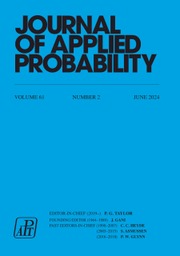Crossref Citations
This article has been cited by the following publications. This list is generated based on data provided by
Crossref.
Gray, Jr., A. H.
1968.
Level Touchings in a Restricted Random Walk.
SIAM Journal on Applied Mathematics,
Vol. 16,
Issue. 6,
p.
1123.
Percus, Ora Engelberg
and
Percus, Jerome K.
1969.
On the Distribution of the Number of Zero Partial Sums.
Journal of Applied Probability,
Vol. 6,
Issue. 01,
p.
162.
Percus, Ora Engleberg
and
Percus, Jerome K.
1970.
Extended criterion for comparison of empirical distributions.
Journal of Applied Probability,
Vol. 7,
Issue. 01,
p.
1.
Percus, Ora Engelberg
and
Percus, Jerome K.
1971.
Generating functions for a class of one-dimensional random walks.
Journal of Applied Probability,
Vol. 8,
Issue. 01,
p.
110.
Sen, Kanwar
1971.
Distribution of crossings in restricted paths.
Acta Mathematica Academiae Scientiarum Hungaricae,
Vol. 22,
Issue. 1-2,
p.
23.
Iosifescu, M.
and
Tăutu, P.
1973.
Stochastic processes and applications in biology and medicine I.
Vol. 3,
Issue. ,
p.
11.
Takács, Lajos
1979.
Fluctuation Problems for Bernoulli Trials.
SIAM Review,
Vol. 21,
Issue. 2,
p.
222.
MOHANTY, GOPAL
1979.
Lattice Path Counting and Applications.
p.
85.
Krattenthaler, C
2006.
Watermelon configurations with wall interaction: exact and asymptotic results.
Journal of Physics: Conference Series,
Vol. 42,
Issue. ,
p.
179.
Chen, William Y.C.
Li, Nelson Y.
and
Shapiro, Louis W.
2007.
The butterfly decomposition of plane trees.
Discrete Applied Mathematics,
Vol. 155,
Issue. 17,
p.
2187.
Wildon, Mark
2010.
Knights, spies, games and ballot sequences.
Discrete Mathematics,
Vol. 310,
Issue. 21,
p.
2974.
Janse van Rensburg, E J
2010.
The adsorption transition in directed paths.
Journal of Statistical Mechanics: Theory and Experiment,
Vol. 2010,
Issue. 08,
p.
P08030.
van Rensburg, E J Janse
2010.
Adsorbing Motzkin paths.
Journal of Physics A: Mathematical and Theoretical,
Vol. 43,
Issue. 48,
p.
485006.
van Rensburg, E J Janse
2011.
Adsorption of pulled directed paths in a slanted boundary.
Journal of Physics A: Mathematical and Theoretical,
Vol. 44,
Issue. 32,
p.
325001.
 possible different paths are equally probable, and assume also, without loss of generality, that a ≧ b.
possible different paths are equally probable, and assume also, without loss of generality, that a ≧ b.
